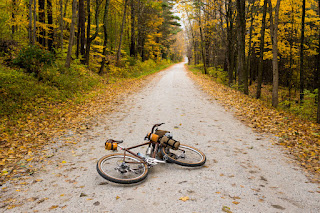It's this season again when if you really have to go to the mall, better go there by bike. Otherwise, you are at risk of being stuck in heavy car traffic for a half an hour just to enter the parking lot, only to wait another hour to find a parking spot.
Anyway, as I mentioned before, I think the best time to try to ride your bike in the city in exactly now - between Christmas and New Year's Day. Last night I was on my way to a liquor store to pick up some wine for the Christmas dinner when some dude in a pimpmobile yelled at me for slowing him down by roughly 3, maybe 4, seconds. I think he yelled "Move!", although I could swear that from the outside of his car it sounded a lot more like "I have a small d**k!".
Everyone seems rushing these days, especially right before Christmas, but drivers are always impatient. It's almost like once we sit behind the steering wheel, we stop to notice anyone else on the road. If you're on a bicycle - you lost. If you're a pedestrian - forget it. You may as well stay home, since crossing American streets is a sport for only the very patient and determined ones.
My mom, my sister, and her 4-month-old trying to cross a street in Chattanooga, TN.Unsignalized crosswalks are a decades-long gaslight perpetrated by traffic engineers on America's pedestrians. pic.twitter.com/JKZQ4odWiX— The Pumpkin Spice Must Flow (@WarrenJWells) December 18, 2019
Neighbors near Arkansas Ave. and Varnum Street have been asking to make the intersection safer and tonight I saw why. pic.twitter.com/K5SRvF8aB1— Janeese Lewis George (@Janeese4DC) December 13, 2019
You may think, in the future we won't have this problem - autonomous cars will automatically stop for pedestrians at the crosswalks, but I wouldn't be so sure. Apparently, car companies now basically program their AVs to kill you. That is - to kill you if you're a pedestrian. They don't want to harm their clients - the drivers. Something tells me that if you take a self-driving car to your destination, dying in a crash due to software error should be a calculated risk you should be signing for. It was your choice to "drive" after all.
But that won't happen anytime soon. We will have to wait longer for all new cars to come with a massive door sticker "Driving kills". Which is why my idea for automated red light pop-up bollards at every intersection and crosswalk should be implemented ASAP.
Meanwhile, we could just start with banning cars on at least the most walkable streets in the city. After living in the Boston area for the last 15+ years, I still don't understand why neither Newbury St, nor Hanover St (to give just two examples) are not permanently closed for cars (any thru-traffic).
Or we could take the highways out of our cities...
But we won't, because as Michelle Wu said - barriers are almost entirely political:
My takeaways from today’s @GlobeSpotlight #SeeingRed:— Michelle Wu 吳弭 (@wutrain) November 20, 2019
🛑 We’re not imagining it. Traffic really is that bad
🚍 Our transpo system is in crisis but we know how to fix it! Even small shifts have a big impact
🕴The barriers are almost entirely POLITICALhttps://t.co/PRqhzazDwg
It's true. We're not trying to push boundaries in some antimatter research here - we know what to do: solutions exist and good examples are plentiful. But until the leadership changes, we will stay stuck in traffic, wait for the bus that never comes and be yelled by an impatient pimp with an undersized wiener.








































